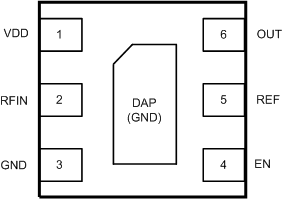SNWS018D December 2006 – June 2016 LMV221
PRODUCTION DATA.
- 1 Features
- 2 Applications
- 3 Description
- 4 Revision History
- 5 Pin Configuration and Functions
- 6 Specifications
- 7 Detailed Description
- 8 Application and Implementation
- 9 Power Supply Recommendations
- 10Layout
- 11Device and Documentation Support
- 12Mechanical, Packaging, and Orderable Information
Package Options
Mechanical Data (Package|Pins)
- NGF|6
Thermal pad, mechanical data (Package|Pins)
Orderable Information
5 Pin Configuration and Functions
NGF Package
6-Pin WSON
Top View

Pin Functions
| PIN | TYPE | DESCRIPTION | |
|---|---|---|---|
| NUMBER | NAME | ||
| 1 | VDD | Power supply | Positive supply voltage |
| 3 | GND | Power ground | |
| 2 | RFIN | Analog input | RF input signal to the detector, internally terminated with 50 Ω. |
| 4 | EN | Logic input | The device is enabled for EN = high, and brought to a low-power shutdown mode for EN = Low. |
| 5 | REF | Output | Reference output, for differential output measurement (without pedestal). Connected to inverting input of output amplifier. |
| 6 | OUT | Ground referenced detector output voltage (linear in dB) | |
| DAP | GND | — | Ground (must be connected) |